Do you want moderate comments on your WordPress site but don’t know where to get started?
WordPress comes with a built-in comment system that allows for community interaction around your content.
In this beginner’s guide, we will show you how to moderate comments in WordPress, deal with comment spam, and everything related to comments.
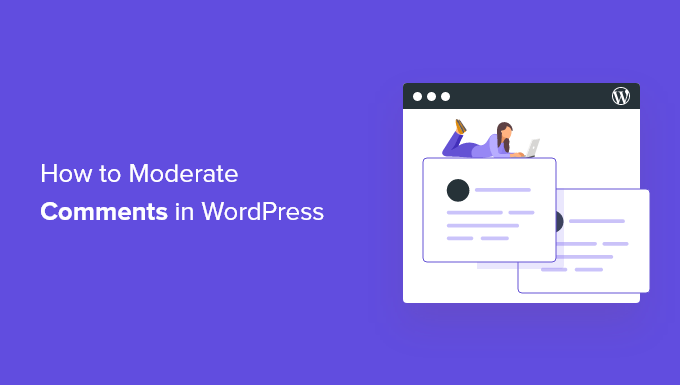
What Are Comments in WordPress?
Comments allow your website visitors to communicate with you and other readers. They can add their input on a specific article that you had written, ask questions, and provide feedback.
On most WordPress sites, anyone with a valid name and email can leave a comment without verifying their identity.
By default, comments are turned on. There will be a comment form displayed at the bottom of any blog post or page, though it may look different or not appear depending on the WordPress theme you’re using.
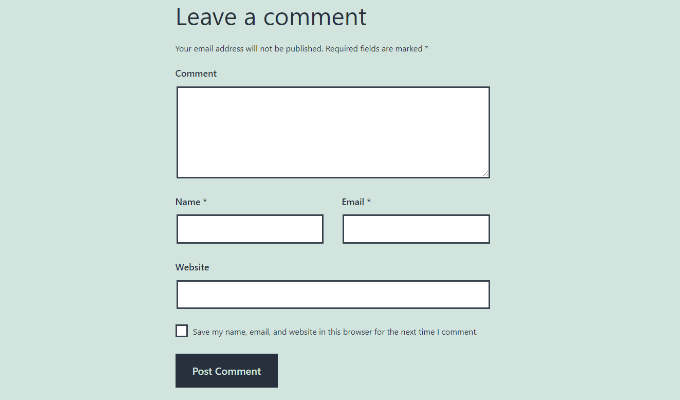
Once someone submits a comment, they will see a preview of their comment and a message saying that the comment is awaiting moderation.
Before the comment appears for other visitors, it will be held for moderation for you to approve or delete. This allows you to control what appears on your website.
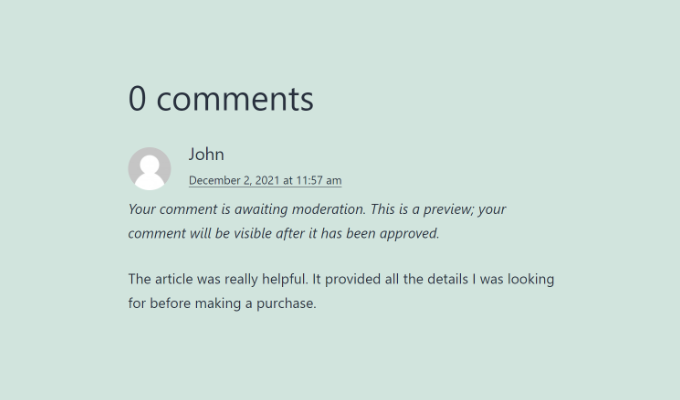
That said, let’s look at how you can moderate comments on your website.
Moderating Comments in WordPress
You can see all comments on your WordPress website by clicking on the ‘Comments’ menu in the WordPress dashboard.

On the comments page, you will see 5 different tabs, including all comments, mine, pending, approved, spam and trash. Comments that need your approval will appear under the Pending tab.
To approve a comment, take your mouse over to the comment, and you will see action links appear below it. Click on the ‘Approve’ button to make a comment publicly visible on your website.
You can also reply to a comment by clicking on the reply link. Replying to comment automatically approves the comment as well.
If you see a comment that looks or feels spammy, then you can mark it as Spam. You’re probably wondering, what does a spam comment look like?
Well, there are a few different indicators that you can use to tell if a comment is a spam:
- Comments with a bunch of links, keywords, and strange characters – This is the most obvious type of spam comment. They could also contain inappropriate content in the comment.
- Comment with a Fake Name – If you see a comment that’s being left by a person named “Best Mortgage Rates” or “Cheap Printer Ink”, then you can clearly tell it’s a marketer trying to spam your site for a backlink.
- Generic Comments – Often spammers rely on generic comments to bypass your spam filter. These generic comments are “Thank You”, “Really Nice Article”, or insert the title of your post and make a generic statement (example: I agree beginners guide to comment moderation is essential).
Filter Spam Comments using Akismet
To filter spam comments from your WordPress website, you can use Akismet. It’s a spam filtering WordPress plugin and is developed by Automattic.
Once you mark a comment as spam, Akismet will learn to catch similar comments in the future.
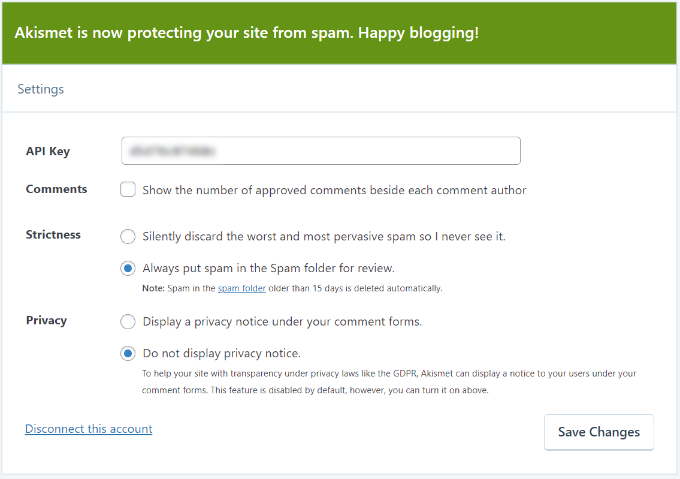
For more details, you check out our guide on what is Akismet and why you should use it.
All comments marked as spam will appear under the spam tab. You will not need to visit this tab that often. However, if a user complains that their comments are not appearing on your website, then this is the first place you should look.
If you find a comment that is wrongly caught by Akismet as spam, then simply click on the ‘Not Spam’ link to move it from spam to pending.

You can also click on the ‘Empty Spam’ button to delete all spam comments at once. Even if you don’t, spam comments will be automatically deleted by WordPress after 15 days.
Remember that deleting thousands of spam comments at once can slow down your site a bit. If you are trying to delete thousands of spam comments, then you can perform a bulk action. You can check out our guide on how to quickly batch delete spam comments in WordPress.
If for some reason you accidentally got hundreds of spam comments appearing in the ‘Pending’ tab, then simply click on the ‘Check for spam’ button.
This will trigger a spam check on existing comments on your website, and Akismet will move spam comments from Pending to Spam.
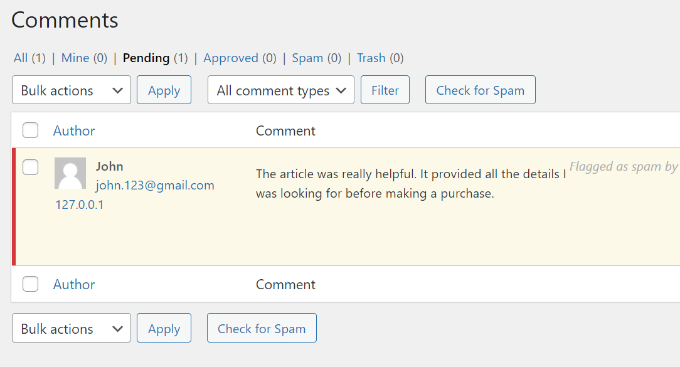
If you want to remove a comment without marking it as spam, then simply click on the ‘Trash’ link below the comment.
Comments deleted by you will be sent to the trash and will live there for the next 30 days. After this time, WordPress will automatically delete them forever.
If you accidentally deleted a comment, then simply visit the trash tab and click on the ‘Restore’ link below the comment.
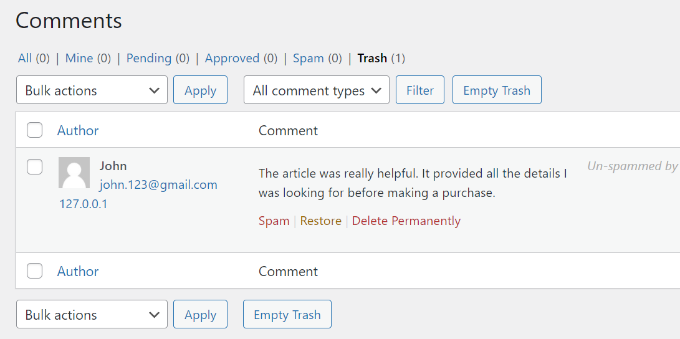
The comment moderation area shows comments for all posts and pages. However, you can individually view the comments left on a particular post by either visiting that post on your site or through your admin area.
Turn Comments On/Off for Specific Posts in WordPress
There are some times when you don’t want comments to be enabled on certain posts. WordPress allows you to turn comments off for single posts or pages.
Simply edit a post and on the WordPress editor screen, open the ‘Discussion’ box from the settings menu on your right. Next, you can uncheck the box for the ‘Allow comments’ option.
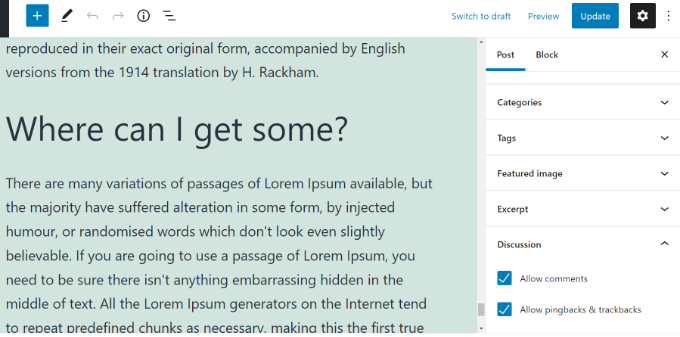
You can also go to Posts » All Posts from your WordPress dashboard and click the ‘Quick Edit’ button for any blog post. After that, simply uncheck the ‘Allow Comments’ option.
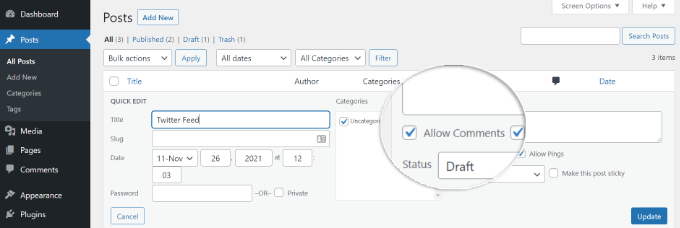
Allow Blog Users to Moderate Comments in WordPress
If you have lots of articles and get many comments every day, then it can be a challenge to moderate all the WordPress comments.
A simple solution to this issue is having a dedicated comment moderator on your website. You can assign a separate comment moderator role to a user that’s an active commenter on your site or a member of your customer support team.
WordPress doesn’t offer a user role that’s dedicated to moderation comments. However, you can use the Comment Moderation Role plugin.
The plugin is created by our team at WPBeginner, and it allows you to give users access to only see the comment moderation screen in WordPress. You can assign the role to existing and new users.
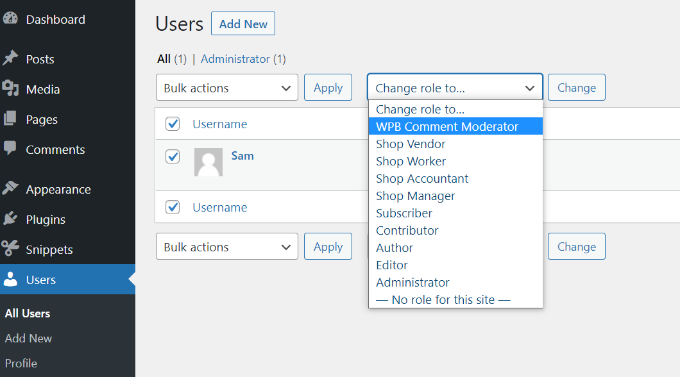
For more details, please see our guide on how to allow blog users to moderate comments in WordPress.
Comment Settings Configuration
Finally, WordPress allows you to change comment configuration for your entire site.
The comments settings page is located under Settings » Discussion. There are different sections on the discussion settings page, and we will walk you through each option on the page.

Default post settings
The top section on the discussion settings screen controls the Default post settings.
The first option in this section allows your blog to notify other blogs when you link to them in an article. The second option allows similar notifications from other blogs to be accepted on your site.
These are called pingbacks and trackbacks, and we recommend you to uncheck both these options. The first option can slow down your entire site, and the second option would bring you a lot of spam comments.
The third option on the article settings screen is ‘Allow people to post comments on new posts,’ enabling comments for all new articles you write on your WordPress site. It is important to note that you can turn comments on and off for individual articles like we showed you earlier in this article.
Other comment settings
Under the other comment settings section, you will notice the first option as ‘Comment author must fill out name and email.’ This option makes it mandatory for comment authors to provide a name and email address with their comments.
You need to check this option unless you want to allow anonymous commenting on your website.

There is also an option to require users to register to your site before leaving a comment however, in our opinion, it’s not necessary for most sites.
You will also see the option for closing comments on older articles. Some website owners use this to prevent spam, but it’s completely a personal preference.
WordPress allows users to reply to comments. Those replies will appear nested under the original comment only if you check the box next to ‘Enable threaded (nested) comments’ and you can specify how deep these nested comments can go.
Having too many levels can distort the readability of comments. The default setting of 5 levels is good enough for most WordPress themes.
If one of your articles becomes popular and starts getting too many comments, then you will notice that the comment section will become too long. Users will have to scroll a lot to read the latest comments on the article.
To address this problem, you can check the option to break comments into pages. By default, this option allows 50 top-level comments, you can increase or decrease this. Choosing this option will also show the last page of comments first.
Another option is to show your most recent comments first.
Email me whenever and Before a comment appears settings

The next section allows you to receive emails whenever a user leaves comments on your site or whenever a comment is held for moderation. This option is only exciting for the first few days of your website. As you get more comments, these emails become annoying, so we recommend turning them off.
Under the ‘Before a comment appear’ section, the first option is to approve each comment manually. Make sure this box is checked so that no comment can appear on your site without your approval.
Below this, you will see the ‘Comment author must have a previously approved comment’ option.
If this option is checked, comments from authors with a previously approved comment will appear without explicit approval. Simply uncheck this option to make sure that all comments are manually approved.
Comment Moderation settings

A very common trait among automated spam comments is that they contain a lot of links. Since you have already set your comments to be manually approved, all your comments will go to the moderation queue regardless of how many links they have.
You will see a larger text area where you can enter words, IP and email addresses, or URLs that you want to watch out for. Any comment matching things you enter here will be sent to the moderation queue.
There is no need for you to enter anything here since you have already set all comments to be manually approved, and they are all going to the moderation queue anyways.
Avatars settings
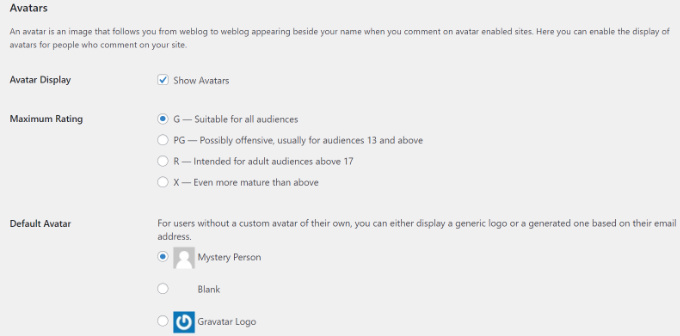
The last section on the comments settings screen is for Avatars. These are the images that appear next to the comment author’s name on your website.
WordPress uses Gravatar, which is a free service that allows users to have the same avatar on all the blogs they visit (see our guide on what is Gravatar).
WordPress uses Mystery Person as the default gravatar when a comment author doesn’t have a Gravatar image associated with their email address. You can change this by selecting a default avatar from the list or even add your own custom default gravatar in WordPress.
That’s all! You have configured your comment settings. Don’t forget to click on the Save Changes button to store your settings.
We hope this article helped you learn how to moderate comments in WordPress. You may also want to check out our guide on how to start an online store and best WooCommerce plugins.
If you liked this article, then please subscribe to our YouTube Channel for WordPress video tutorials. You can also find us on Twitter and Facebook.
